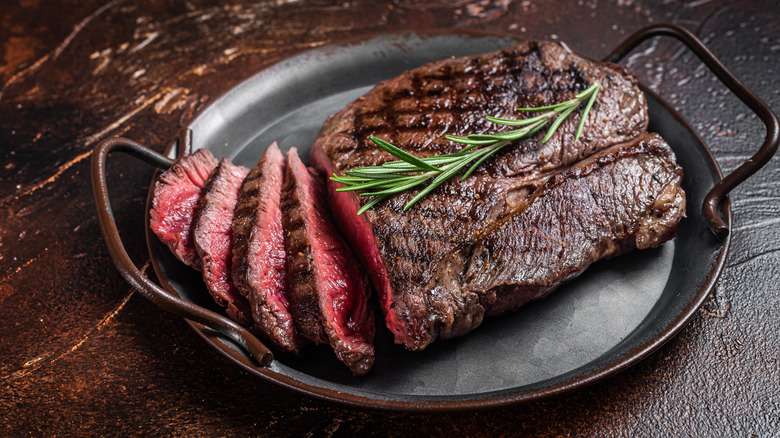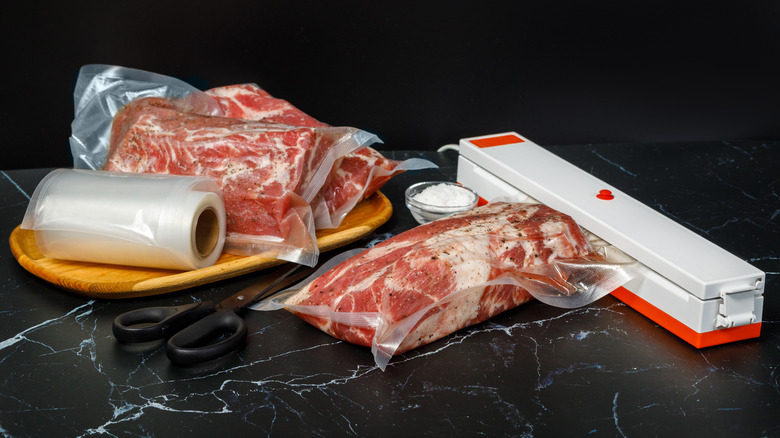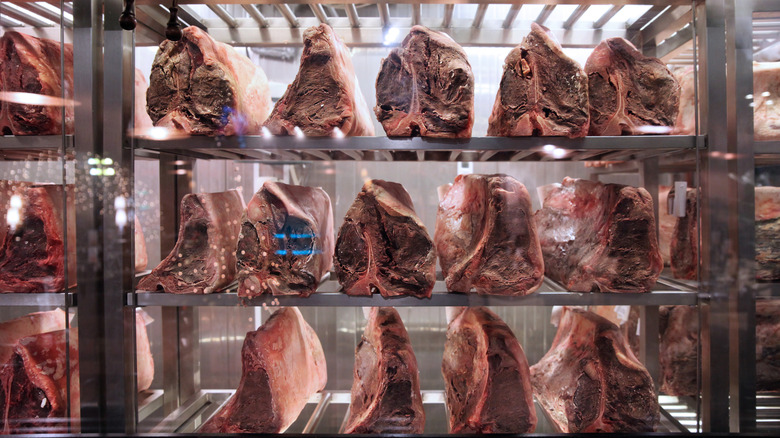What It Means When Meat Is 'Wet Aged'
You've probably heard of dry aging. It's an extremely popular technique wherein meats are kept in a climate-controlled environment for weeks or even months on end to tenderize and concentrate their flavor. Many steakhouses serve dry-aged meats, and countless connoisseurs will tell you it's the best way to eat steak. But the thing is, dry-aged meats aren't for everyone. The process imparts a powerful, nutty flavor that many love, but some find unpleasant. Dry-aged steaks are more expensive too, prohibitively so for some, and the process is rather tricky to pull off at home. Fortunately, if dry-aged meat isn't up your alley, there's another lesser-known technique called wet aging that serves a similar purpose.
The term "wet-aged" is a bit odd, as the actual process doesn't involve adding any liquids to the meat. There are no brines or marinades to work with; in fact, it's much, much simpler. While dry-aged meats are aged in an open-air environment (in a special chamber that keeps both temperature and humidity low), wet-aged meats are aged in a vacuum-sealed bag, resting in their own juices for weeks. Like dry aging, wet aging uses time to tenderize meat, but unlike dry aging, wet aging preserves the meat's original flavor, resulting in an end product that many describe as fresher-tasting than a dry-aged steak (whether that's preferable is a matter of opinion). Better yet, wet aging is easy to do at home. So, let's find out how it works.
How wet aging works
At their core, dry aging and wet aging work on the same principle, and we're warning you now, it's a little bit gross. When we talk about aging meat, we're really talking about the natural decay of flesh after death. When an animal is slaughtered, its body quickly goes into rigor mortis, making the muscles tense and tough, but then, a group of enzymes called calpains starts to break down the muscle fiber. In the long term, this will eventually result in the total decay of the body, but in the short term, it's great for meat. If we let calpains do their thing in a climate-controlled space free from the risk of parasitic invasion, they act as a tenderizing agent, transforming tough muscle fibers into delectably supple morsels.
You can wet age meat at home as long as you have vacuum-sealable bags. Simply seal up a pre-portioned cut of meat in an airtight bag and leave it in your refrigerator for between one week and one month. During this time, the steak ages in its own juices, resulting in less moisture loss than in the dry aging process. Wet aging has some skeptics who criticize it as a cheap substitute for dry aging, but they miss that the two processes are meant to achieve different results in terms of flavor. Plus, according to The Atlantic, 90% of steaks sold in American groceries have been wet aged, and goodness knows we love gobbling those up.
Wet aging vs. dry aging
The key difference between dry-aged meat and wet-aged meat? Moisture loss. During the dry-aging process, a lot of water evaporates, resulting in two effects. First, reducing the water content makes the flavor of the meat more concentrated, and, second, it reduces the meat's size, sometimes by a significant amount. Furthermore, the exterior of a dry-aged cut will harden and develop mold (it's safe to eat, like the mold on blue cheese, but nevertheless the exterior of dry-aged meats is usually cut off, further shrinking the cut). With wet aging, the meat incurs no moisture loss, and therefore no reduction in size. However, it will not develop flavor like a dry-aged steak, though, again, some people prefer the subtler taste.
These two aging techniques are suited to different meat cuts. Dry aging is best for fatty cuts like ribeyes, T-bones, and strip steaks, as during the dry-aging process, fat recedes into the muscle, imparting additional flavor and tenderness. Wet aging is perfect for lean cuts, which can't afford to lose any moisture lest they become too dry and tough. Steaks like the flatiron and filet mignon are perfect for wet aging. So is wild game since those animals live more active lives, developing tougher muscle fibers that can make for tough eating unless you tenderize them.
Is wet aging or dry aging superior? That's a matter of opinion, so decide your course of action based on personal preference and the type of meat you're working with.


